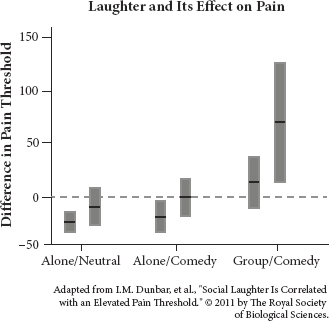PSAT Reading Practice Test 21
Questions 1-9 refer to the following information.
Laughter Passage
Today's technology and resources enable people
to educate themselves on any topic imaginable, and
human health is one of particular interest to all.
From diet fads to exercise trends, sleep studies to
05nutrition supplements, people strive to adopt health-
ier lifestyles. And while some people may associate
diets and gym memberships with sheer enjoyment,
most of the population tends to think of personal
healthcare as a necessary but time-consuming,
10energy-draining, less-than-fun aspect of daily life.
Yet for centuries, or perhaps for as long as
conscious life has existed, sneaking suspicion has
suggested that fun, or more accurately, funniness, is
essential to human health. Finally, in recent years
15this notion, often phrased in the adage, "Laughter is
the best medicine," has materialized into scientific
evidence.
When a person laughs, a chemical reaction in the
brain produces hormones called endorphins. Other
20known endorphin-producing activities include
exercise, physical pain, and certain food choices,
but laughter's appearance on this list has drawn
increasing empirical interest. Endorphins function
as natural opiates for the human body, causing what
25are more commonly referred to as "good feelings."
A boost of endorphins can thwart lethargy and pro-
mote the mental energy and positivity necessary to
accomplish challenging tasks. Furthermore, recent
data reveal that the laughter-induced endorphins are
30therapeutic and stress reducing.
This stress reduction alone indicates signifi-
cant implications regarding the role of laughter in
personal health. However, humor seems to address
many other medical conditions as well. One study
35from Loma Linda University in California found
that the act of laughing induced immediate and
significant effects on senior adults' memory capaci-
ties. This result was in addition to declines in the
patients' cortisol, or stress hormone, measurements.
40Another university study found that a mere quarter
hour of laughter burns up to 40 calories. Pain toler-
ance, one group of Oxford researchers noticed, is
also strengthened by laughter—probably due to the
release of those same endorphins already described.
45And a group of Maryland scientists discovered that
those who laugh more frequently seem to have
stronger protection against heart disease, the illness
that takes more lives annually than any other in
America. Studies have shown that stress releases
50hormones that cause blood vessels to constrict,
but laughter, on the other hand, releases chemicals
that cause blood vessels to dilate, or expand. This
dilation can have the same positive effects on blood
flow as aerobic exercise or drugs that help lower
55cholesterol.
Already from these reputable studies, empirical
data indicates that laughter's health benefits include
heart disease prevention, good physical exertion,
memory retention, anxiety remedy, and pain
60resilience—not to mention laughter's more self-
evident effects on social and psychological wellness.
Many believe that these findings are only the begin-
ning; these studies pave the way for more research
with even stronger evidence regarding the powerful
65healing and preventative properties of laughter. As
is true for most fields of science, far more can be
learned.
As for how laughter is achieved, these studies
used various methods to provoke or measure laugh-
70ter or humor. Some used comedy films or television
clips; others chose humor-gauging questionnaires
and social—or group—laughter scenarios. Such
variance suggests that the means by which people
incorporate laughter into their daily routine matters
75less than the fact that they do incorporate it.
However, it should be said that humor shared in an
uplifting community probably offers greater benefits
than that found on a screen.
It is believed that young people begin to laugh
80less and less as they transition to adulthood.
Time-pressed millennials might, in the interest of
wellness, choose isolated exercise instead of social-
or fun-oriented leisure activities. However, this
growing pool of evidence exposes the reality that
85amusement, too, can powerfully nourish the health
of both mind and body. Humor is no less relevant to
well-being than a kale smoothie or track workout.
But, then, some combination of the three might be
most enjoyable (and, of course, beneficial) of all.
